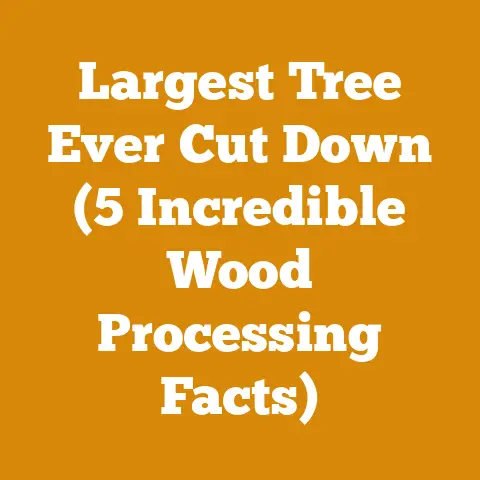Elm Firewood Benefits (5 Hardwood Facts You Must Know)
Alright, let’s dive into the world of elm firewood!
Elm Firewood: 5 Hardwood Facts You Must Know (And How to Save Money!)
I’ve seen it happen too many times. A friend, eager to heat his home with wood, excitedly tells me about the “deal” he got on a truckload of “mixed hardwoods.” Turns out, a good chunk of it was elm. He was frustrated, to say the least, when he realized it wasn’t the BTU powerhouse he’d envisioned. That’s why I’m writing this – to arm you with the knowledge you need before you burn your hard-earned cash on the wrong firewood. This article will cover the benefits of elm firewood, bust some myths, and, most importantly, show you how to budget for your firewood needs like a pro.
What is Elm Firewood Good For?
Elm, often overlooked in favor of oak or maple, has some redeeming qualities as firewood. Let’s break down the facts.
-
Moderate Heat Output: Elm isn’t the hottest burning hardwood, but it’s far from the worst. It sits comfortably in the middle of the pack. On average, elm produces around 20 million BTUs (British Thermal Units) per cord. This compares to oak (around 24-30 million BTUs) and softwoods like pine (around 15-20 million BTUs). The specific BTU output will depend on the species of elm (red elm tends to be slightly higher) and, crucially, its moisture content.
- Data Point: The USDA Forest Service provides detailed BTU ratings for various wood species. You can often find this information through your local extension office.
- Personal Insight: I once burned a mix of elm and maple in my wood stove during a particularly mild winter. The elm’s moderate heat output was perfect for keeping the house comfortable without overheating it.
-
Relatively Easy to Split (Sometimes): This is where elm gets tricky. Freshly cut elm can be notoriously stringy and difficult to split. However, once it’s seasoned (dried), it becomes significantly easier. The key is to split it green (freshly cut) using a hydraulic splitter or to wait until it’s well-seasoned.
- Cost Factor: If you’re paying someone to split your wood, the difficulty of splitting green elm can increase labor costs. Expect to pay a premium if you request green elm to be split.
- Tool Tip: A good maul or splitting axe can make all the difference. I’ve found that a maul with a wedge-shaped head works best for elm.
-
Good Coaling Properties: Elm creates a decent bed of coals, which helps maintain a consistent fire overnight. This is a big plus if you’re using your wood stove as your primary heat source.
- Experience: I’ve noticed that elm coals tend to burn cleaner than some other hardwoods, producing less ash.
-
Moderate Smoke Production: Properly seasoned elm burns relatively cleanly, producing a moderate amount of smoke. This is important for minimizing creosote buildup in your chimney. Creosote is a flammable substance that can cause chimney fires.
- Safety First: Always have your chimney inspected and cleaned regularly, regardless of the type of wood you burn.
-
Availability and Cost: In many regions, elm is more readily available and, therefore, cheaper than premium hardwoods like oak or hickory. This can make it an attractive option for budget-conscious homeowners.
- Market Watch: Firewood prices vary significantly depending on location, season, and demand. I recommend checking with local firewood suppliers to get an accurate estimate.
The Elm Firewood Challenge: Splitting and Seasoning
Let’s address the elephant in the woodpile: elm’s reputation for being difficult to split.
- The Stringy Factor: Elm’s interlocking grain makes it incredibly tough to split when green. The fibers tend to tear and bind, rather than cleanly separating.
- The Solution:
- Hydraulic Splitter: If you’re dealing with large quantities of green elm, a hydraulic splitter is your best friend. These machines can generate tons of force, making even the most stubborn logs manageable.
- Seasoning: Allowing elm to season for at least 12-18 months (and preferably longer) dramatically improves its splitability. As the wood dries, the fibers become more brittle and less prone to binding.
- Wedges: Using splitting wedges can help you create a starting point for your axe or maul. Drive the wedge into the log and then strike it with your axe or maul.
- Personal Story: I once spent an entire afternoon wrestling with a single elm log. It was an exercise in futility. I finally gave up and let it season for a year. When I came back to it, it split like butter.
Seasoning Elm: A Step-by-Step Guide
- Split the Wood: Split the elm into manageable pieces (about 6-8 inches in diameter). This will speed up the drying process.
- Stack it Properly: Stack the wood in a single row, off the ground, in a sunny and windy location. This will maximize airflow and promote rapid drying.
- Cover the Top: Cover the top of the woodpile with a tarp to protect it from rain and snow. Leave the sides open to allow for ventilation.
- Be Patient: Allow the wood to season for at least 12-18 months, or longer if possible. Use a moisture meter to check the moisture content. You want it to be below 20%.
- Moisture Meter Tip: A good moisture meter is an invaluable tool for anyone who burns wood. It allows you to accurately assess the moisture content of your wood and ensure that it’s properly seasoned.
The Cost of Splitting:
- Manual Splitting: If you’re splitting the wood yourself, the cost is primarily your time and the wear and tear on your tools. A good splitting axe or maul can cost anywhere from $50 to $200.
- Hydraulic Splitter Rental: Renting a hydraulic splitter can cost anywhere from $50 to $100 per day. This is a good option if you only need to split a small amount of wood.
- Professional Splitting: Hiring someone to split your wood can cost anywhere from $50 to $100 per cord, depending on the difficulty of the wood and your location.
Elm Firewood: The 5 Hardwood Facts You Must Know (Revisited)
Let’s recap the key facts about elm firewood:
- Moderate Heat Output: Around 20 million BTUs per cord.
- Splitting Difficulty: Can be challenging when green, easier when seasoned.
- Good Coaling Properties: Creates a decent bed of coals.
- Moderate Smoke Production: Burns relatively cleanly when seasoned.
- Availability and Cost: Often more affordable than premium hardwoods.
Now, let’s dive into the budgeting aspect.
Budgeting for Elm Firewood: A Practical Guide
Here’s where I’ll walk you through creating a realistic budget for your elm firewood needs. I’ll break down the costs, offer practical tips for saving money, and provide real-world examples.
Step 1: Determine Your Firewood Needs
The first step is to estimate how much firewood you’ll need for the heating season. This will depend on several factors, including:
- Climate: The colder your climate, the more firewood you’ll need.
- Heating System: If you’re using a wood stove as your primary heat source, you’ll need more firewood than if you’re only using it occasionally.
- Insulation: A well-insulated home will require less firewood.
- Wood Stove Efficiency: A more efficient wood stove will burn less wood.
Rule of Thumb: A typical home in a cold climate might need 3-5 cords of firewood per year.
Calculating Your Firewood Needs:
Here’s a simple formula to help you estimate your firewood needs:
-
BTU Required = (Heating Degree Days x Home Size x BTU Loss Factor) / Wood Stove Efficiency
- Heating Degree Days: You can find this information for your location from your local weather service.
- Home Size: The square footage of your home.
- BTU Loss Factor: This factor depends on the insulation of your home. A well-insulated home will have a lower BTU loss factor.
- Wood Stove Efficiency: The efficiency rating of your wood stove (usually expressed as a percentage).
-
Cords of Firewood = BTU Required / BTU per Cord of Firewood
- BTU per Cord of Firewood: As mentioned earlier, elm produces around 20 million BTUs per cord.
Example:
Let’s say you live in a climate with 6,000 heating degree days, your home is 1,500 square feet, your BTU loss factor is 5, and your wood stove efficiency is 70%.
- BTU Required = (6,000 x 1,500 x 5) / 0.70 = 64,285,714 BTUs
- Cords of Firewood = 64,285,714 / 20,000,000 = 3.2 cords
Therefore, you would need approximately 3.2 cords of elm firewood for the heating season.
Step 2: Estimate the Cost of Elm Firewood
The cost of elm firewood will vary depending on your location, the time of year, and the supplier.
- Price per Cord: The average price per cord of firewood in the United States ranges from $150 to $400. Elm, being a more common hardwood, will likely fall on the lower end of this range. I’ve seen it go for $180-$250 in my region.
- Data Point: Check local classifieds, online marketplaces, and firewood suppliers to get an accurate estimate of the price per cord in your area.
- Delivery Fees: Many suppliers charge a delivery fee. This fee can range from $25 to $100, depending on the distance.
- Stacking Fees: Some suppliers will also stack the firewood for you, but this will come at an additional cost. Expect to pay around $25 to $50 per cord for stacking.
- Permits and Taxes: In some areas, you may need to obtain a permit to burn firewood. You may also have to pay sales tax on your firewood purchase.
Example:
Let’s say you need 3.2 cords of elm firewood, the price per cord is $200, the delivery fee is $50, and you’re not paying for stacking.
- Cost of Firewood = 3.2 cords x $200/cord = $640
- Delivery Fee = $50
- Total Cost = $640 + $50 = $690
Therefore, your estimated cost for elm firewood would be $690.
Step 3: Factor in Splitting and Seasoning Costs
If you’re buying unsplit wood, you’ll need to factor in the cost of splitting and seasoning.
- Splitting Costs: As mentioned earlier, splitting costs can range from $0 (if you’re doing it yourself with hand tools) to $100 per cord (if you’re hiring someone).
- Seasoning Costs: The primary cost of seasoning is your time. However, you may also need to invest in tarps to cover the woodpile. A good tarp can cost anywhere from $20 to $50.
Example:
Let’s say you’re buying unsplit elm, you’re splitting it yourself with hand tools, and you need to buy a tarp for $30.
- Splitting Costs = $0
- Tarp Cost = $30
- Total Cost = $30
Therefore, your estimated splitting and seasoning costs would be $30.
Step 4: Create a Detailed Budget
Now, let’s put it all together and create a detailed budget for your elm firewood needs.
| Item | Cost |
|---|---|
| Firewood (3.2 cords) | $640 |
| Delivery Fee | $50 |
| Splitting Costs | $0 |
| Tarp | $30 |
| Total Estimated Cost | $720 |
Step 5: Look for Ways to Save Money
Here are some practical tips for saving money on elm firewood:
- Buy in Bulk: Buying a larger quantity of firewood can often result in a lower price per cord.
- Buy Off-Season: Firewood prices tend to be lower in the spring and summer, when demand is lower.
- Cut Your Own Firewood: If you have access to a woodlot, you can cut your own firewood. This can save you a significant amount of money. However, be sure to obtain the necessary permits and follow all safety precautions.
- Safety Note: Cutting your own firewood can be dangerous. Always wear appropriate safety gear, including a helmet, eye protection, and hearing protection.
- Split Your Own Firewood: Splitting your own firewood can save you money on labor costs.
- Season Your Own Firewood: Seasoning your own firewood can save you money on the cost of buying seasoned wood.
- Negotiate with Suppliers: Don’t be afraid to negotiate with firewood suppliers. You may be able to get a better price if you’re willing to pay in cash or buy a larger quantity.
- Consider Alternative Fuels: If elm firewood is too expensive in your area, consider alternative fuels such as pellets or propane.
Case Study: Saving Money on Firewood
I once helped a friend save over $200 on his firewood bill by following these tips. He bought unsplit elm in the spring, split it himself, and seasoned it over the summer. He also negotiated a lower price with the supplier by paying in cash.
Step 6: Track Your Expenses
It’s important to track your expenses throughout the heating season to ensure that you’re staying within your budget. Use a spreadsheet or notebook to record all of your firewood-related expenses.
Example Spreadsheet:
| Date | Item | Cost | Notes |
|---|---|---|---|
| 2023-04-01 | Firewood (2 cords) | $400 | Unsplit elm, delivered |
| 2023-04-01 | Tarp | $30 | To cover woodpile |
| 2023-11-01 | Moisture Meter | $25 | To check seasoning |
| Total | $455 |
Beyond the Budget: The Environmental Impact of Elm Firewood
While budgeting is crucial, it’s also important to consider the environmental impact of your firewood choices.
- Sustainable Harvesting: Ensure that your firewood comes from a sustainable source. Look for suppliers who practice responsible forestry management.
- Burning Practices: Burn your firewood efficiently to minimize emissions. Use a modern, EPA-certified wood stove.
- Transportation: Minimize the distance that your firewood is transported. This will reduce carbon emissions.
- Tree Planting: Consider planting trees to offset the carbon emissions from burning firewood.
Elm Firewood: The Final Verdict
Elm firewood isn’t the absolute best, but it’s a solid option, especially if you’re on a budget. Its moderate heat output, decent coaling properties, and availability make it a worthwhile choice for many homeowners. Just be prepared for the splitting challenge (or the extra cost of paying someone else to do it) and ensure it’s properly seasoned.
Actionable Takeaways:
- Assess your heating needs: Calculate how much firewood you’ll need for the heating season.
- Shop around: Compare prices from different firewood suppliers.
- Buy off-season: Take advantage of lower prices in the spring and summer.
- Split your own wood: Save money on labor costs by splitting your own firewood.
- Season your wood properly: Ensure that your firewood is properly seasoned before burning it.
- Track your expenses: Monitor your firewood-related expenses to stay within your budget.
By following these tips, you can enjoy the warmth and comfort of a wood fire without breaking the bank. And remember, even “mistakes” like getting a load of elm can turn into a learning experience – and a warmer home!






